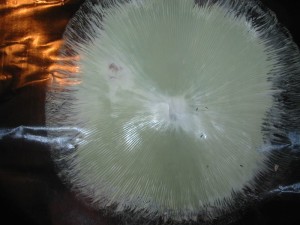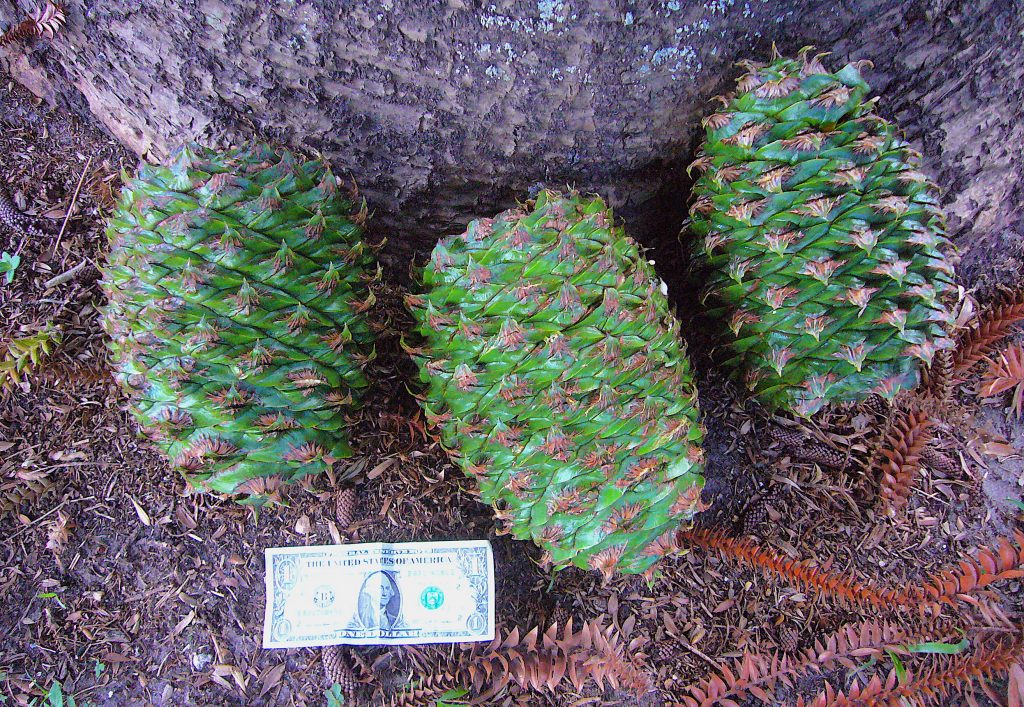
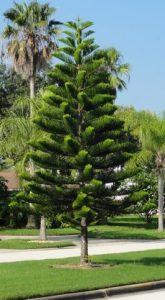
Bunya Bunya get no respect in countries where people have plenty of food. The falling large cones — about this time of year — are consider a legal hazard and the trees are often cut down (as they were at the entrance to Bok Tower in Lake Wales. That plant preserve is the last place one would think they would be removed.) The bigger the cone the more likely it will have kernels in the shells. It is a bit of work to get the enclosed nuts out of their green husks. As the kernel taste more like chestnuts than pine nuts I prefer to roast them. This also makes the outer shell more brittle and easier to crack. You can read more about the Bunya-Buya here. A reasonably close relative with edible seeds is the Norfolk Island Pine, upper right. They used to be standard landscaping fare and are far more common. Also called the Norfolk Pine, the species is common in warm, humid coastal areas because the species is quite salt tolerant (though there is one down the street from me in the middle of the state.) At one time the greater family included a huge amount of species ranging over much of the earth. Botanists tell us that most of them died out along with the dinosaurs leaving just a few species ranging from South America to Australia. While in its native habitat the Norfolk Pine can reach 150 feet high and 10 feet through in North America it is often a house or office plant popular because it somewhat resembles a stringy Christmas tree.
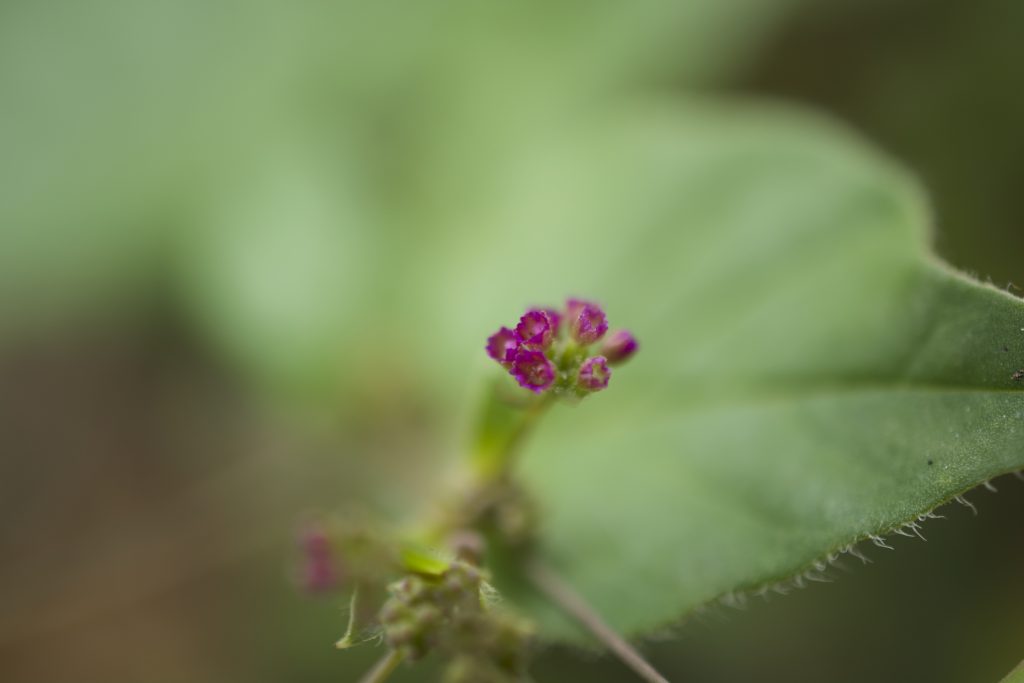
Foraging is like treasure hunting. While pedaling along a bike trail I had to stop at an intersection and noticed some Boerhavia diffusa. It’s a common marginal edible probably from India or somewhere near there. One usually finds it in somewhat trashy ground such as sidewalk cracks, parking lots, and dumps. So when I stopped at the intersection it was no surprise to see Boerhavia growing there. But growing next to it was a white Boerhavia, B. erecta. The leaves are more pointed than the common species and it’s a Florida native. B. erecta, the “Erect Spiderling” or “Erect Boerhavia” has spread to other parts of the world and is reportedly edible and medicinal like B. difussa. You can read about the ruby-blossomed B. diffusa here.
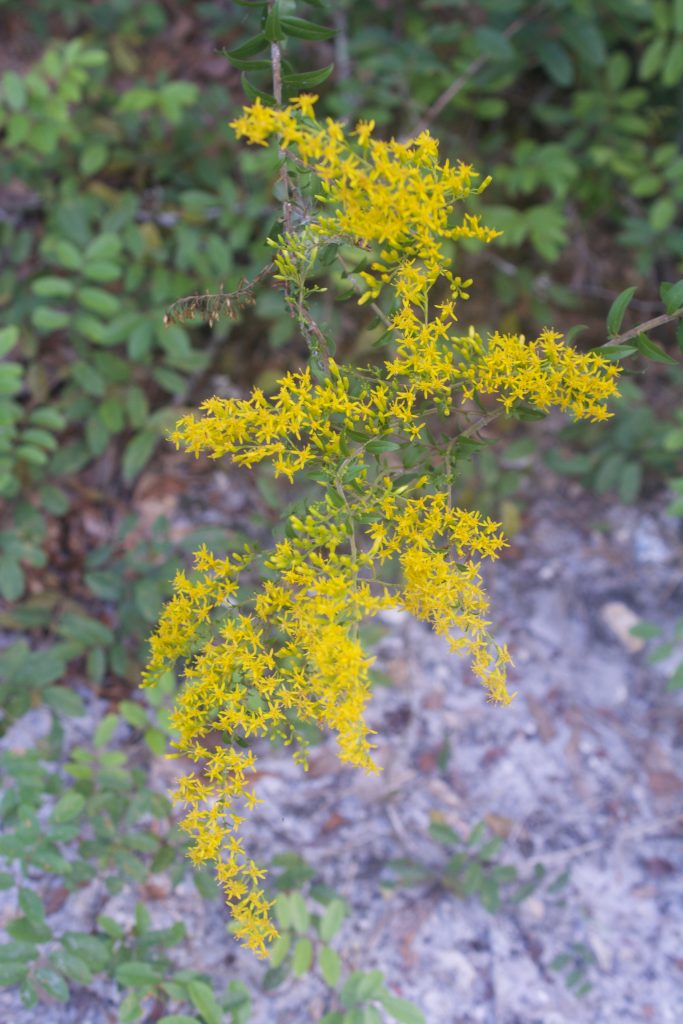
Also seen on bike trails and blooming now is Goldenrod. It is a bit of a treasure hunt and disappointment. The treasure hunt is that one species is better than all the rest for tea, Solidago odora. It does grow here, has an anise flavor, but is hard to find. It’s reported in most counties but is not common. Goldenrod grows in about half of the United States, southwest to northeast. Other Goldenrod species can also be made into tea, perhaps all of them particularly for herbal applications, but they don’t taste anywhere near as good. In fact, after the “Boston Tea Party” of 1773 halted tea imports colonialists drank Goldenrod tea and even exported some to China. It did not catch on. However, every time I see a Goldenrod I pull off a leaf and crush it hoping to detect the tell-tale anise smell. It’s a golden treasure hunt.
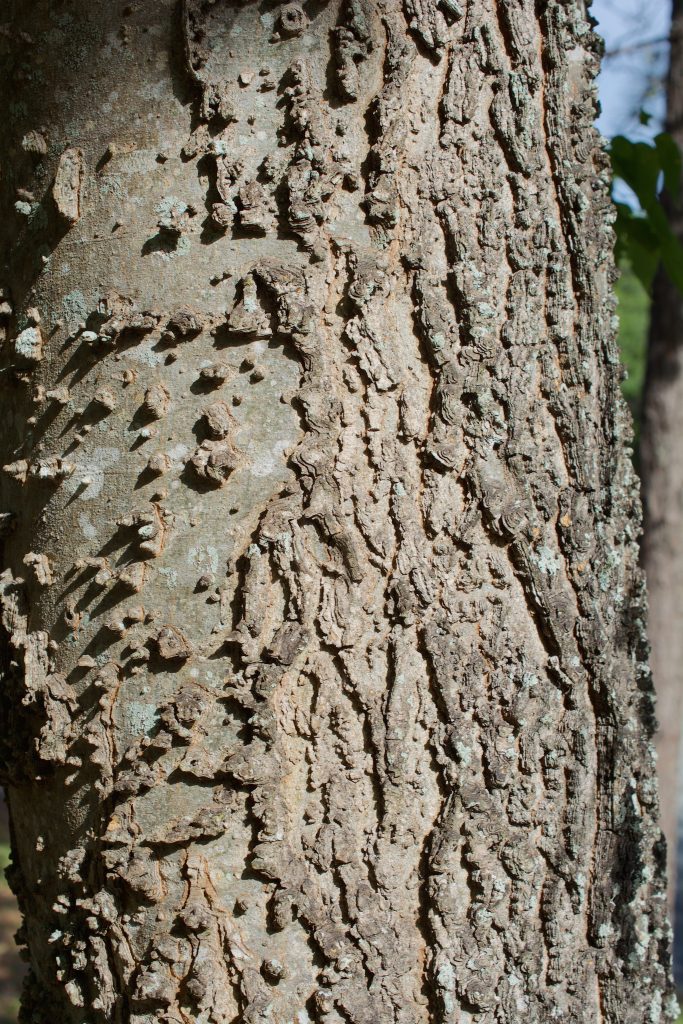
There is a tree you should be scouting for now so when the fruit ripens next month you’ll have some already located. As in real estate so in foraging: Location, location, location. Hackberries (also widely know as Sugarberries) like to be near but not in fresh water. You can often find them about 10 feet above the local water table but I’ve seen them as low as three feet. Usually you can find them up the bank from the water. Older Hackberry bark will often be warty, sometimes heavily so. Leaves have uneven shoulders, and on the back side of the leaf notice three prominent veins at the base, unusual for tree leaves. The small-pea sized fruit is green this time of year but will ripen to a burnt orange. The entire fruit is edible though the seed is hard. To read more about them go here.

My foraging classes this weekend range from Jacksonville to north central Florida in Cassadaga. The Jacksonville campus is always a pleasant location with great diversity. Colby Park in Cassadaga is a small but fruitful place that historically draws small classes. More personal attention that way. It has edible “Yams” and good examples of Kudzu.
Saturday, August 10th, Florida State College, south campus, 11901 Beach Blvd., Jacksonville, 32246. 9 a.m. to noon. We will meet at building “D” next to the administration parking lot.
Sunday, August 11th, Colby-Alderman Park: 1099 Massachusetts Street, Cassadaga. Fla. 32706. 9 a.m. to noon. Meet by the bathrooms.
Saturday August 17th, Eagle Park Lake, 1800 Keene Road, Largo, FL 33771. 9 a.m. to noon. Meet at the pavilion near the dog park.
Sunday August 18th, Ft. Meade Outdoor Recreation Area, 1639 Frostproof Highway, Fort Meade, FL 33841. (Frostproof Highway is also Route 98.) 9 a.m to noon. Meet at the bathrooms in the middle of the park which is due south from the highway and not near the entrance.
Saturday, August 24th, Bayshore Live Oak Park, Bayshore Drive. Port Charlotte. 9 a.m. to noon. Meet at the parking lot at the intersection of Bayshore Road and Ganyard Street. 9 a.m. to noon.
Sunday, August 25th, Blanchard Park, 10501 Jay Blanchard Trail, Orlando, FL 32817. 9 a.m. to noon. Meet next to the tennis courts by the YMCA building.
Saturday August 31st, Wekiva State Park, 1800 Wekiwa Circle, Apopka, Florida 32712. 9 a.m. to noon. Arrive very early as there will be a lot of people wanting to go to the springs at 8 a.m. to swim. There is a park admission Fee: $6 per vehicle. Limit 8 people per vehicle, $4 for a single occupant vehicle, $2 pedestrians or bicyclists. Meet at the Sand Lake parking lot (road on left after entrance. Go to end of road.) Unlike city parks or the urban area, Wekiva Park is “wild” Florida. There are very few weeds of urbanization. The edibles are mostly native plants and far between. There is a lot of walking in this class. After class you can swim in the spring.
Sunday September 1st, George LeStrange Preserve, 4911 Ralls Road, Fort Pierce, FL, 34981. 9 a.m. to noon. The preserve has no official bathroom or drinking water so take advantage of the various eateries and gas stations before arrival.
Saturday September 7th, 329 N. Park Avenue, Winter Park. 9 a.m. to noon. Parking is free in the parking garage behind Panera’s. This is a class specializing in finding wild edibles in an urban setting.
Sunday September 8th, Ft. Desoto Park, 3500 Pinellas Bayway S. St. Petersburg Fl 33715. Meet by the bathrooms at the parking lot of the “bay” fishing pier (not the “gulf” fishing pier.) 9 a.m. to noon. There is a fee to get into the park. The fishing pier is about halfway along the SW/NE road along the southern end of the park.
Saturday, September 14th, Wickham Park: 2500 Parkway Drive, Melbourne, FL 32935-2335. 9 a.m. to noon.Meet at the “dog park” inside the park.
October 11-12-13, foraging classes at Putney Farm, Honea Path, South Carolina.
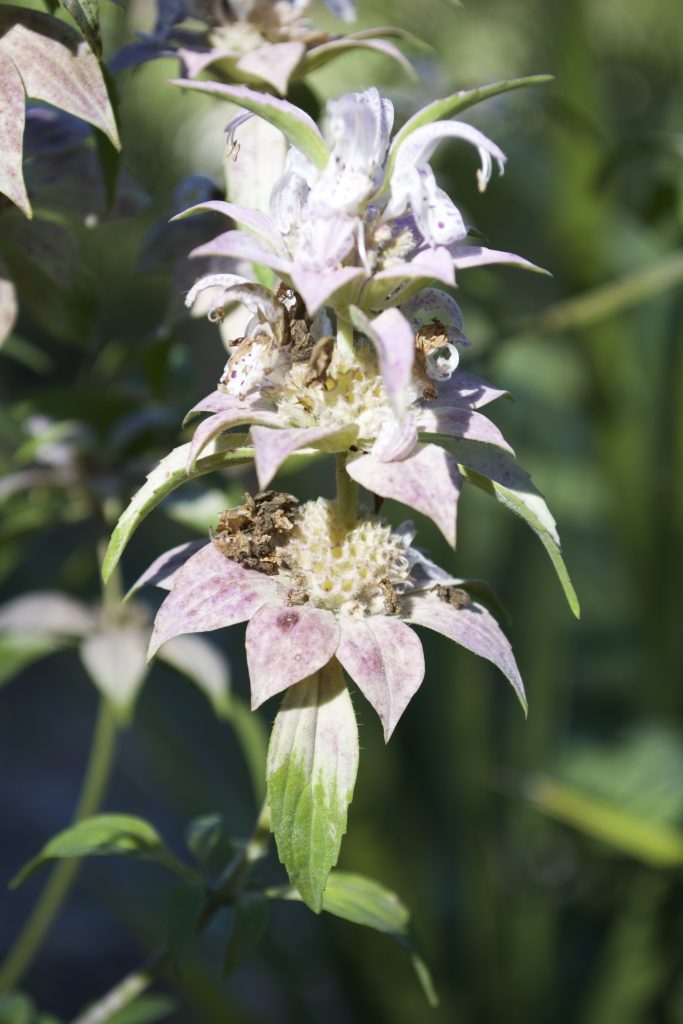
Wild mints are prima donnas. Once on stage they hate to get off. Locally I would expect to see Horsemint, Monarda punctata, in full bloom this month but late rains might have pushed the season back. Horsemint can flower for several months. I have found some unshowy ones located exactly where one would expect to find it: On a dry bank up from a trail. You can also find it in the same area near roads especially roads that cut through a sand hill. Look for the showy pink bracts. If you’re in the Carolinas you’ll be seeing the bright red Monarda didym. Where I grew up in New England the wild mints were called Oswego Tea.
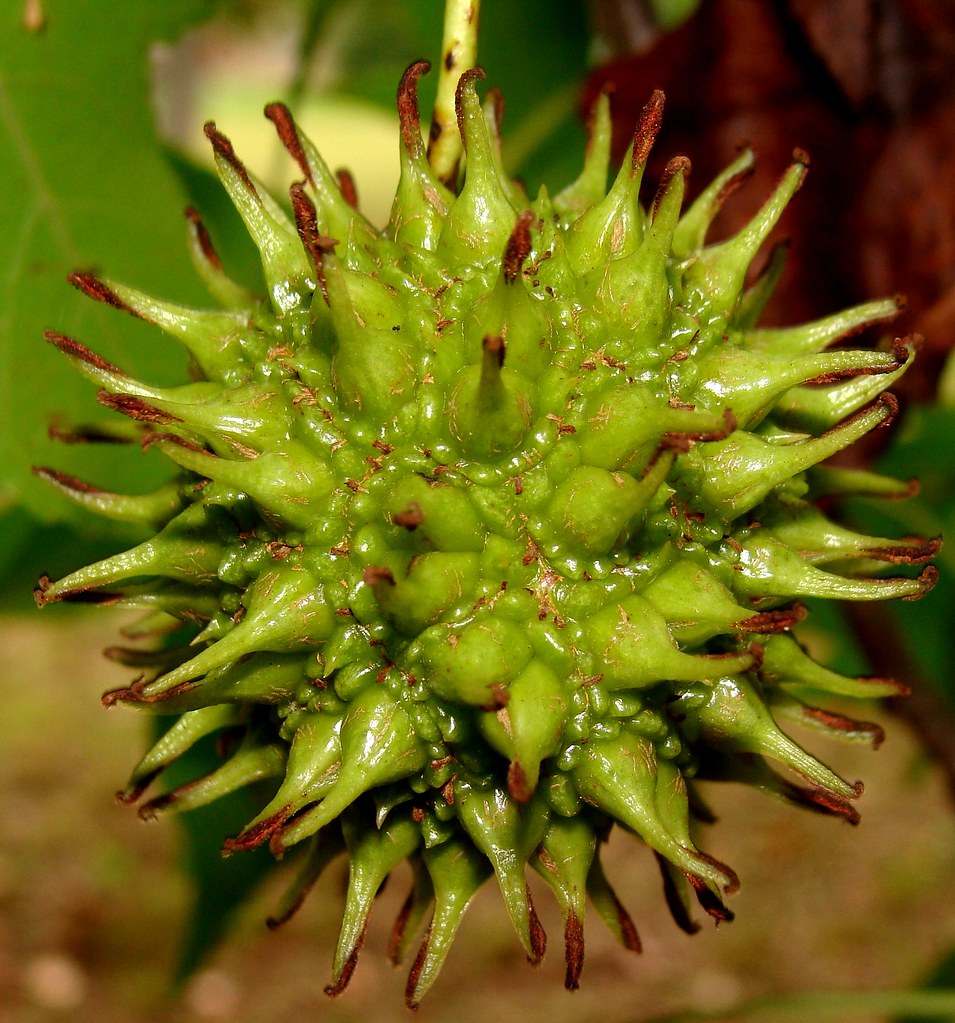
Do you know why the Sweet Gum tree is called that? Because while it tastes mighty bad it is not as bad as the other “gum” trees, one of which is not season yet but is fruiting, the Black Gum. You have to like sour and bitter to like the Black Gum tree. If you don’t the fruit is offensive and elicits comments that cannot be printed in wholesome publications. This did not stop desperate settlers from adding a lot of sugar to the fruit and making jelly out of it. The seed itself is easy to identify in that under the pulp there are vertical striations covering the seed. I have seen the species in classes in Gainesville and Jacksonville. The tree usually looks gangly and has branches that are often on a 90-degree angle to the trunk. To read more about the Black Gum and its nearly-offensive but edible relatives click here.
What is that mushroom on your lawn? Locally a toxic mushroom has been flourishing, the Green Spore Parasol also called the Green Parasol and the False Parasol, Chlorophyllum molybdites . It causes more non-fatal mushroom poisonings than any other species in North America. This is because it has some close look alikes that are edible. The Green Spore Parasol is almost unique in that it is one of the very few mushrooms with green spores. If you pull off the stem and lay the cap on a white piece of paper or clear plastic for a few hours to a day it will leave a green spore print. They almost aways pop up on lawns and often in a “troop” or what we used to call a fairy ring. Also called the “Gut Wrencher” a few people seem immune to its toxin but don’t try it. The one death on record involved a two-year old child who ate some raw, had convulsions, then died 17 hours later. Adults usually get go-to-the-hospital diarrhea, among other gastro-intestional symptoms. There is, however, no lasting organ damage. The mushroom is, however, is deadly to horses. (There is one reference to edibility after processing a particular way but I have not tried it.)

Want to identify a plant? Perhaps you’re looking for a foraging reference? You might have a UFO, an Unidentified Flowering Object you want identified. On the Green Deane Forum we — including Green Deane and some 8,000 others from around the world — chat about foraging all year. And it’s not just about warm-weather plants or just North American flora. Many nations share common weeds so there’s a lot to talk about, such as the one to the left. There’s also more than weeds. The reference section has information for foraging around the world. There are also articles on food preservation, and forgotten skills from making bows to fermenting food. Recent topics include: Roadside Plant. Weed In Garden. Those Special Places. Yellow Fruit Found Along River. Bee Humor. Pretty Purple Plant. Cultivated Apios Americana, Mushroom Identification Tips, Another Bolete: Edible? Wood Potato, Chocolate Mushie, Are All Crown Berries Edible? Keeping our cells young, Apple-like fruit on a vine, Square stem and balls of flowers, Is the saw Palmetto supposed to be bitter? Is This A Young Dandelion? Looks Like A Thistle Flower. Mint? Is This A Gopher Apple? and No Flower Too Wrong. You can join the forum by clicking on the button on the upper right hand side of this page.

We shouldn’t forage along railroad tracks and you can blame it all on the Russian Thistle. This species, best known as the tumble weed that rolls across the wild west in movies, came with immigrants to southern South Dakota in the early 1870’s. Best guess is it contaminated their flax seed. By 1895 it reached New Jersey and California. The question was how? A professor who worked for the Department of Agriculture figured out the trains were spreading the seeds coast to coast. It was a remarkable idea at the time and brought him much fame. His solution to the unintentional distribution? Kill plants long railroad tracks. Thus began the practice of putting down some mighty and long-lasting chemicals to kill weeds sprouting amongst the iron rails. Railroad tracks are, however, a good source of exotic seeds.

All My Videos are available for free on You Tube. They do have ads on them so every time you watch a Green Deane video I get a quarter of one cent. Four views, one cent. Not exactly a large money-maker but it helps pays for this newsletter. If you want to see the videos without ads and some in slightly better quality you can order the DVD set. It is nine DVDs with 15 videos on each for a total of 135 videos. Many people want their own copy of the videos or they have a slow service and its easier to order then to watch them on-line. The DVDs make a good gift for that forager you know especially as spring is … springing. Individual DVDs can also be ordered or you can pick and choose. You can order them by clicking on the button on the top right hand side of this page (if your window is open wide enough.) Or you can go here.

Donations to upgrade EatTheWeeds.com and fund a book have gone well. Thank you to all who have contributed to either via the Go Fund Me link, the PayPal donation link or by writing to Green Deane POB 941793 Maitland FL, 32794. Recent upgrades have been paid now the Forum needs work and several function
This is weekly newsletter 367. You can sign up for this free newsletter by clicking on menu (or find in the command line) Newsletter Sign-up.
I am in the need for a part-time webmaster who knows WordPress and who would like to exchange web work for foraging classes. The job would consist up upgrading or resolving some current issues — mostly minor – to solving future issues as they arise.

